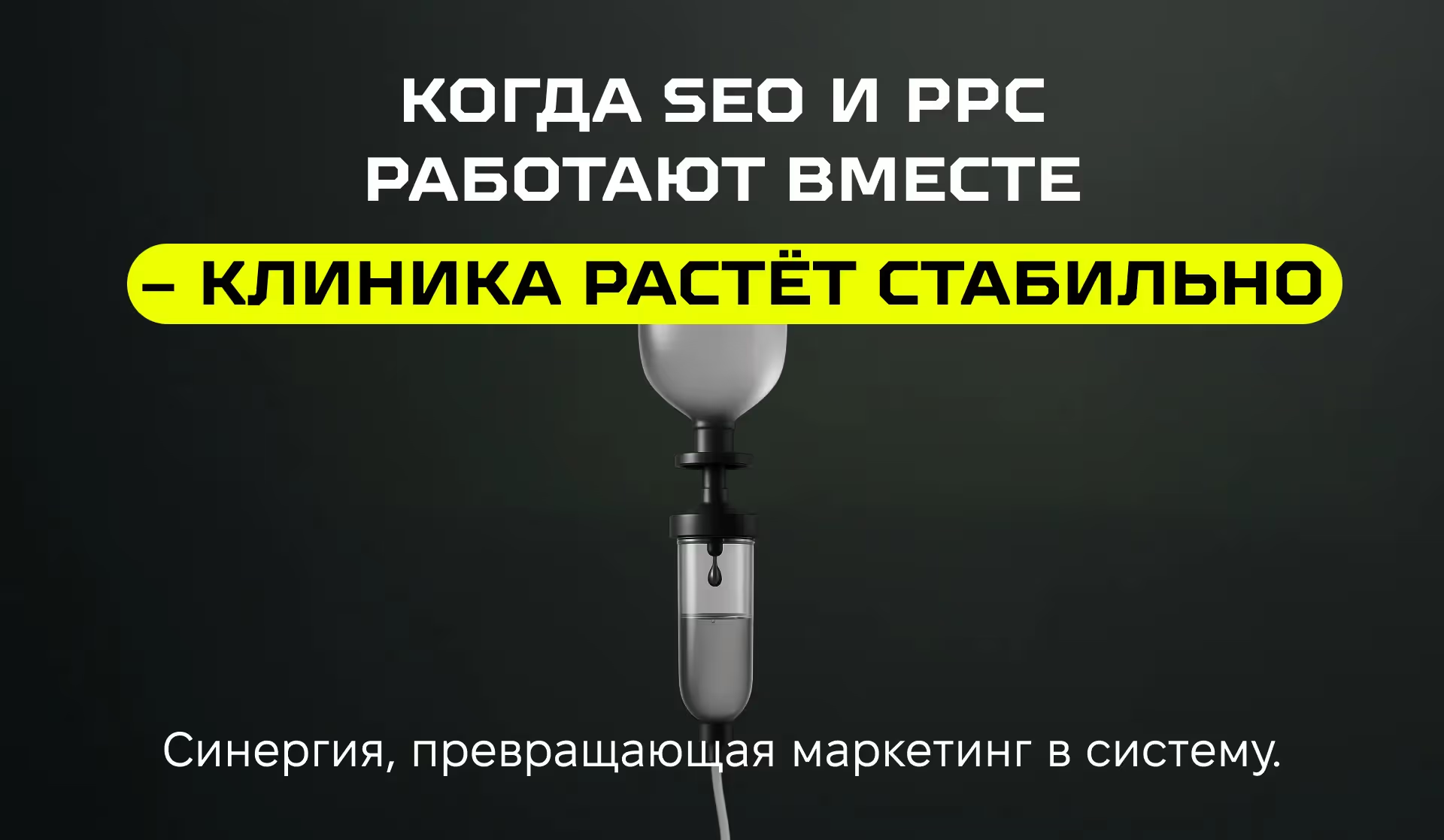In medicine, the “set up a campaign and wait for an application” approach no longer works. The patient is not just looking for a service - he is looking for an answer to whom to entrust his health. And that's where SEO and PPC come into play.
At Lokomotiv, we do not divide marketing into “search” and “advertising” marketing. We are building a patient engagement system where SEO creates trust and visibility, and PPC ensures a constant flow of calls. Over the past two years, we have tested this combination on dozens of medical projects and have seen that it is the combination of organic matter and advertising that gives the clinic stability, predictability and results.
In this article, we will show how this works in practice, using real cases from Oberig, Lipinskii and CitySmile clinics as an example. And let's look at why SEO without PPC (and vice versa) is how to treat symptoms without a diagnosis.
Previously, it was enough for a clinic to invest in either SEO or PPC to get a steady flow of patients. But now the market has changed. Patients compare, read reviews, analyze websites, and they make the decision to record not out of impulse, but out of trust. One channel no longer covers the entire user journey, from search to selection.
SEO gives credibility but not speed. This is the foundation that builds search authority and helps the clinic be visible when a patient is looking for answers to their symptoms or questions. However, SEO results come gradually, and if a business wants to see applications right now, this tool alone is not enough.
PPC, on the other hand, gives speed but not trust. An advertising campaign can bring in hits in a few days, but without high-quality content and an optimized website, a user simply cannot sign up. This is especially noticeable in medicine: the patient will not click “sign up” if he is not sure that the clinic is reliable.
The combination of SEO and PPC solves both problems. Ads attract attention, and SEO builds trust. A person sees an ad, goes to the site, reads an article or a doctor's profile, makes sure and returns ready to sign up. These are not just two tools — it is a system that accompanies the patient at every stage of decision-making.
In medicine, SEO works not only for traffic but also for trust. This is not just technical optimization of the site, but building authority in the eyes of Google and patients. When a person enters “neurologist Kyiv” or “heart aches at night”, he is not looking for a website — he is looking for a safe place. And it is SEO that helps make your clinic this place.
The first step is not content, but the site's health. At the Oberig Clinic, with which we had been working for 22 months, technical errors, duplicate pages and toxic links destroyed positions. We conducted an in-depth audit, cleared backlinks, updated the structure and metadata. The result: traffic increased tenfold, from 16,000 to 175,000 visitors, and the share of pages in the TOP-10 increased from 22% to 42%.

SEO in medicine requires discipline, as in surgery: not a single mistake, not a single flaw. If the site is slow, insecure, or has a chaotic structure, Google doesn't trust, which means it doesn't show.
Patients don't want to read “We are the best clinic” texts. They want answers to their questions. That's why we create informational pages, blogs, and FAQs that don't sell, but explain. This relieves the tension that the user feels before going to the doctor.
At Lipinskii Clinic, we have completely updated the content and structure: we have added separate pages for symptoms, diagnostics and services. As a result, traffic grew by 262% and almost half of key queries reached the TOP 10. People stopped looking for “somewhere nearby” — they started looking for this particular clinic.
Google classifies health websites as YMYL (Your Money Your Life), topics that affect a person's life. This means that content must be expert, verified, and signed by real experts.
We implement this approach in every project:
When all this is put together in a systematic way, Google begins to see the clinic as a reliable source of medical information, and patients as a place to stay.
SEO doesn't produce immediate results, but it's the foundation that keeps businesses going for years. While PPC is generating hits today, SEO ensures a steady flow of patients at no additional cost per click.
And that's why at Lokomotiv we don't see SEO as a separate service — for us, it's part of an ecosystem that allows the clinic to be recognizable, understandable and present in the user's mind.
If SEO is the foundation, then PPC is the engine. Advertising allows the clinic to receive calls today, test demand, test hypotheses and scale without waiting for months. But in medicine, PPC has its own specifics: policy restrictions, high competition, and the need not just to “sell”, but to build trust at first touch.
When a clinic launches a new service or opens a branch office, waiting for SEO to gain momentum is a luxury. This is why Google Ads or Meta ads become a starting point. It makes it possible to receive requests right away, see what queries are working, what services patients are most interested in, and only then scale SEO to proven areas.

This is exactly the logic we used in the CitySmile project. In six months, the number of leads increased from 74 to 186, the CTR tripled from 4.56% to 12.27%, and the cost of a lead fell by almost 40%. We divided the campaigns into areas (“implantation”, “hygiene”, “pediatric dentistry”), tested different messages and left only those that really touched patients' fears — pain, uncertainty, mistrust.
PPC in healthcare isn't just about pressing the “create campaign” button. This is an accurate work with user behavior.
We focus on the following principles:
This approach has proven itself in PPC for Oberig. In six months, the number of leads increased from 40 to 101, CTR rose from 1.2% to 5.95%, and CPL fell from 433₴ to 270₴. This isn't magic — it's attention to detail: we removed ineffective keywords, relaunched creatives with a humane tone, and added extensions with doctors' reviews and contacts.
The patient does not respond to the price if he does not understand the value.
Medical advertising should not be aggressive, but convincing. Therefore, we avoid “discounts” and “promotions”, replacing them with elements of trust: real photos of doctors, videos from the clinic, short cases, quotes from specialists. This reduces the barrier between advertising and real interaction.
In addition to applications, ads provide invaluable data — which queries convert, what pages the user places a request on, and which ads are trustworthy. At Lokomotiv, we use this data not only to optimize campaigns, but also to update our SEO strategy. This creates a closed cycle in which PPC fuels organic matter and SEO enhances advertising effectiveness.
As a result, PPC is becoming not just a source of applications, but a systemic growth tool. It shows what works and what doesn't and allows the clinic to move quickly but not randomly.

Most clinics view SEO and PPC as two different areas. But in reality, these tools only start to have maximum effect when they work together. In medicine, where trust is everything, it's not just a combination of channels — it's a system that accompanies the patient all the way: from the first search to making an appointment.
A patient sees your article in search, reads about symptoms or doctor's recommendations — this is a moment of building trust. A few days later, he sees your clinic's ad on Google or Instagram — this is the moment of action.
This is how the combination of SEO and PPC works:
This is particularly evident in Oberig. While SEO increased site visibility (traffic growth by 1046%), PPC simultaneously ensured a stable flow of hits with a lead cost of 270₴. Organics created interest; ads converted it into records.
Google Ads gives a quick response: which requests get hits, which ones don't work, which messages attract users. We use this information to update our SEO strategy.
For example, when CitySmile best converted the queries “pediatric dentist nearby” and “it hurts after implantation”, we created SEO pages for these queries. After a few months, they began to generate traffic without advertising costs.
This makes it possible to reduce advertising budgets without losing results, gradually transferring effective trends to organic.
When a site is well optimized, ads become cheaper. High-quality content, fast loading times, and relevant pages increase ad rankings (Quality Score), which means they reduce CPC. In PPC Oberig, this reduced the cost per click by 25% while maintaining the same amount of traffic.
In addition, a user who has seen your brand in a search takes the ad as confirmation rather than as an imposition. This increases CTR and trust at the same time.
When SEO and PPC work in synergy, communication becomes holistic.
The patient sees the same tone of voice, the same promises and values — regardless of where they come from: search, advertising, or social media. This creates a sense of stability and professionalism, and this is the strongest trigger for the medical sector.
The result formula is:
SEO provides the foundation.
PPC gives you the pace.
Together they create a flow that doesn't stop.
The combination of SEO and PPC has become not just an effective tool for medical projects, but a strategy that creates stability. When a clinic simultaneously works on trust (through search) and the speed of attraction (through advertising), it creates a full-fledged system that does not depend on seasonality or algorithms. The patient sees the brand in the search results, meets it in the ad and returns ready to sign up.
This approach has proven effective in practice: organic matter is growing significantly, advertising is becoming cheaper, and conversion rates are higher. The clinic no longer fights for random traffic, but works with warm, engaged users who come not because of aggressive messages, but because of a sense of confidence.
SEO and PPC are not two parallel tools, but interrelated mechanisms of the same system. And when they are set up precisely, the clinic stops putting out fires and begins to move along a clear path: from trust to stable growth.
Submit a request, our head of analytics will contact you and show you how we will achieve results for your business